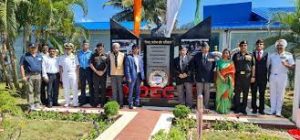31 Dec 2021 Sankalp Memorial: Andaman and Nicobar

Sankalp Memorial: Andaman and Nicobar- Today Current Affairs
- A Sankalp memorial was dedicated to the nation exactly 78 years (December 29, 2021) after Netaji Subhas Chandra Bose’s arrival in India.
- The purpose of this monument is to preserve this important event of history.
Introduction:
- This memorial built in Andaman and Nicobar is a tribute to the resolve and innumerable sacrifices of the soldiers of the Indian National Army.
- It is also a symbol of the values of commitment, duty and sacrifice enshrined by Netaji himself, which underline the ethos of the Indian Armed Forces and the resolve of the Indian Army.
Importance:
- It is also significant that Netaji escaped British surveillance from Kolkata on 16 January 1941 and returned to Indian soil on 29 December 1943 at Port Blair airport after almost three years.
- On December 30, 1943, he unfurled the national flag for the first time on Indian soil at Port Blair.
- Netaji’s visit to the islands as head of the Provisional Government of Azad Hind (known as ArjiHukumat-e-Azad Hind) and supreme commander of the Indian National Army marked the symbolic fulfillment of his promise that the Indian National The army would stand on Indian soil till the end of 1943.
- This historic visit declared Andaman and Nicobar Islands as “India’s first free zone”.
Subhash Chandra Bose: The Hindu Analysis
- Subhash Chandra Bose was born on January 23, 1897 in Cuttack city of Orissa. His mother’s name was Prabhavati Dutt Bose and father’s name was Janaki Nath Bose.
- After his early schooling, he attended Ravenshaw Collegiate School. After that he took admission in Presidency College, Kolkata but due to his radical nationalist activities he was expelled from there. After this he went to the University of Cambridge to study engineering.
- In the year 1919, Bose went to London to prepare for the Indian Civil Services (ICS) examination and was selected there. However, Bose resigned from the civil service as he believed that he could not work with the British.
- Subhas Chandra Bose was highly influenced by Vivekananda’s teachings and considered him as his spiritual guru, while Chittaranjan Das was his political mentor.
- In the year 1921, Bose took over the editing of the newspaper ‘Forward’ published by the Swaraj Party of Chittaranjan Das.
- In the year 1923, Bose was elected President of the All India Youth Congress as well as the Secretary of the Bengal State Congress.
- In the year 1925, he was sent to Mandalay prison due to his association with the revolutionary movements, where he contracted tuberculosis.
- In the mid-1930s, Bose traveled to Europe. He did research first and then wrote the first part of the book ‘The Indian Struggle’, in which he covered all the freedom movements of the country during the year 1920-1934.
- Bose formed the National Planning Commission in the year 1938 (Haripura) after being elected the President of the Indian National Congress. This policy was not compatible with Gandhian thought.
- In the year 1939 (Tripuri), Bose was re-elected president but soon he resigned from the post and formed a faction within the Congress ‘All India Forward Bloc’, whose aim was to strengthen the political left.
- He died in a plane crash in Japan ruled Formosa (now Taiwan) on 18 August 1945.
Indian National Army: The Hindu Analysis
- He reached Japan-controlled Singapore from Germany in July 1943, from there he issued his famous slogan ‘Delhi Chalo’ and on 21 October 1943 announced the formation of the Azad Hind Government and the Indian National Army.
- The INA was first formed under the leadership of Mohan Singh and the Japanese Major Iwaichi Fujiwara, and was formed in response to the British-Indian Army’s war against the Japanese occupied Singapore in the Malayan (present-day Malaysia) campaign. Indian prisoners were included.
- The INA included both Indian prisoners in Singapore jail and Indian nationals from South-East Asia. Its military strength increased to 50,000.
- INA fought allied forces within India’s borders at Imphal and Burma in the year 1944.
- However, with the fall of Rangoon, the Azad Hind government became an effective political entity.
- Immediately after the INA people were prosecuted by the British government in November 1945, there were large-scale demonstrations across the country.
Effect:
- The INA experience caused a wave of discontent in the British Indian Army during 1945–46, culminating in the Bombay Naval Mutiny in February 1946, which forced the British government to leave India as soon as possible.
Structure of INA: The Hindu Analysis
- The INA was essentially a non-sectarian organization, as it had a large Muslim population in its officers and ranks, and it also started a women’s contingent named after the Rani of Jhansi.


No Comments